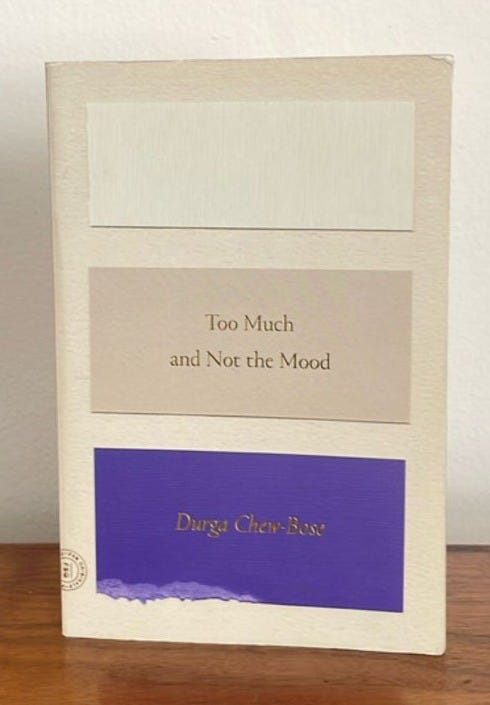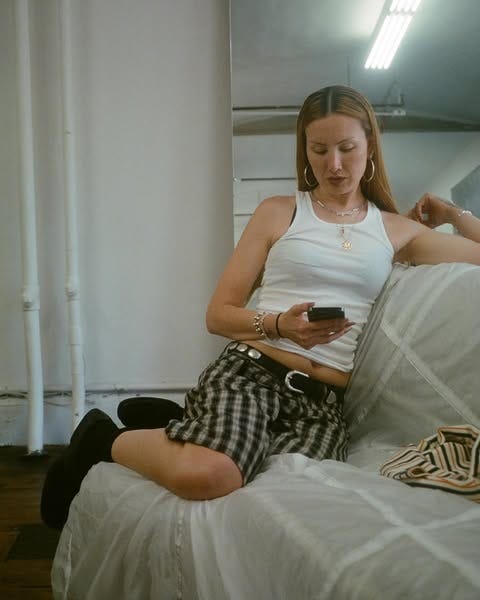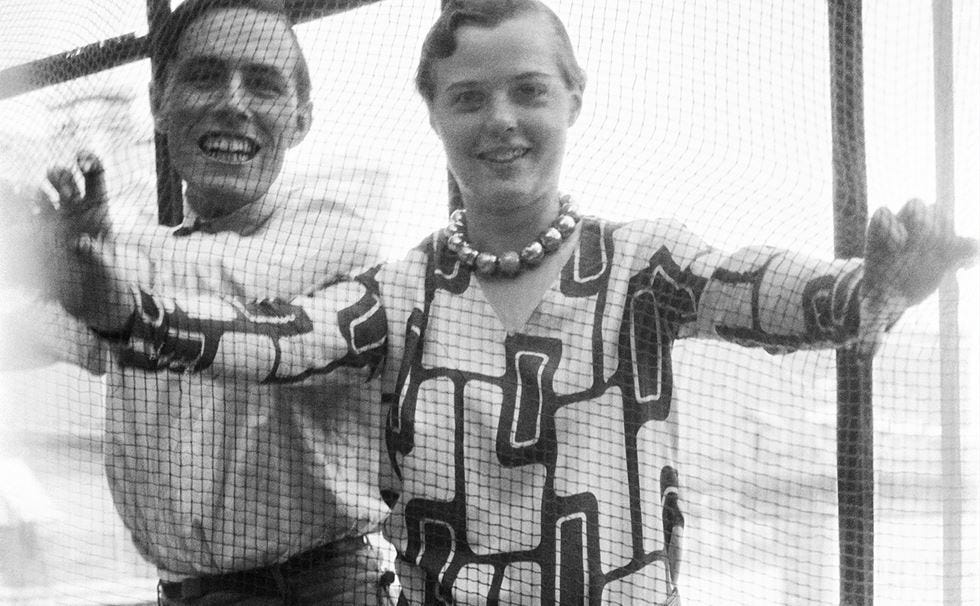A Thread about the year's most stylish film
Style and fashion go head to head in this new indie drama
Last night I went to see the film Bonjour Tristesse, the new adaptation of François Sagan’s 1954 novel, published when the author was just 18.
The film combines the talents of three women I hugely admire; Durga Chew-Bose (writer and director), Miyako Bellizzi (costume designer) and Chloë Sevigny (leading lady). The reason I admire them is not just because of their immense creative talent. More specifically, I admire how they each embody style, that mercurial thing that fashion often pretends to be.
I’ve been following Durga Chew-Bose’s work since I picked up a copy of her book, Too Much and Not in the Mood, just before I left New York in 2017. It’s a collection of essays that sit beneath a chic, Mark Rothko-esque cover, three emotive rectangles of colour that convey the elegance and intensity of Chew-Bose’s writing. It was soon after this book came out that she joined SSENSE, where she ended up as Editor-in-Chief.
These days, we associate SSENSE with its witty social media presence, but it was Chew Bose’s who helped lay the foundations of the retailer’s editorial point of view. Her perspective was uncompromising and astute, drawing a clear line between editorial and commercial. For example, she often commissioned stories about designers that weren’t even stocked on the site, or which took a critical view of the brands they did carry. (If you want to hear more about her work during that era, I recommend this episode of The Cutting Room Floor podcast.)
As for Miyako Bellizzi, I’ve had a style crush on her for years. Most people know her as the costume designer of Uncut Gems, and/or those viral BTS photos of Oscar Isaac and Jessica Chastain trying on the mouthwatering ensembles she created for the show Scenes From a Marriage.
For me, it’s her personal style I really love. In a time when so many fashion outlets try to convince us that ‘timelessness’ is built on a capsule wardrobe of boring, expensive basics, Miyako shows us another way. She’s fashionable without being fashion; nostalgic and yet totally now. Equal parts swag and sophistication.
So you can imagine my excitement when I learned that Bellizzi and Chew-Bose would be collaborating. And then along came Chloë Sevigny to play Anne, the unexpected visitor whose arrival catalyses the drama of the film. She’s also the character that brings capital F fashion into this languid world of easy summer style.
In the film, Chloe’s character Anne is a designer. In every scene, she appears perfectly put together, her elegance translating as slightly over-the-top amongst her loose, languid surroundings. (The film is set in the south of France, where the other characters appear in more relaxed, weather-appropriate ensembles.)
Anne’s jewellery reminded me of the architect and interior designer Charlotte Perriand. In a number of scenes, we see Anne’s face framed by simple silver earrings. In another, she twists a chunky silver ring around her finger. These simple, architectural pieces made me think of Perriand’s signature ‘ball bearing’ necklace, a graphic piece of jewellery she often wore; a symbol of taste, modernity and independence.
Perriand’s style has influenced many designers, including the jeweller Sophie Buhai, who modelled her ‘Perriand’ collar after this famous piece. In researching this story, I discovered that Bellizzi also collaborated with Buhai to create Anne’s jewellery for the film.
Another jewellery designer who features in the movie is Santangelo, (who I’ve referenced a lot in this newsletter). The founder, Anna Santangelo, is a stylist (and friend) with a completely unique creative vision, setting trends but never following them. One of her silver chains appears in the opening shot, draped effortlessly around the neck of Cecile’s summer boyfriend, Cyril. (Cecile is the film’s protagonist, the teenage daughter of Raymond. Anne is an old friend Cecile’s late mother.)
Later in the film, Anne invites Cecile to look at some of her designs. Like many of today’s fashion brands, she’s keen to see if her work resonates with Gen-Z.
I admit this scene made me anxious. The last film I loved about a fashion designer was PT Anderson’s ‘Phantom Thread’ - a perfect film about an English couturier, rendered unconvincing by the fact that the character’s designs are sadly quite hideous!
Luckily, I was surprised and delighted. The drawings were gorgeous, though not especially aligned with the the things Anne herself wears throughout the film. Showing Cecile her designs, she points at an exuberant outfit covered in bows - a far cry from her own restrained elegance. Later in the film, Cecile wears one of her pieces to a party - a shiny satin puffball dress with a matching cape. You get the sense that through her work, Anne is able to access a hidden, hedonistic part of herself - perhaps the woman she was when Cecile’s mother was still alive.
Both the sketches and the outfits were created by Palestinian-Lebanese designer Cynthia Merhej of Renaissance Renaissance, who was the ghost designer behind Anne’s fashion line. “Her stuff is very romantic, costume-y, and there’s a flair to how she designs for the woman’s body that I find really evocative,” said Chew-Bose in Interview.
In the film, we’re told that Cecile’s late mother (Anne’s best friend) was also part of the fashion world, one of Anne’s closest creative collaborators. “We were obsessed with fashion in a way I don’t even remember anymore,” Anne says wistfully. And yet Anne is still gripped by her desire to create beautiful things; to be the creative director of the world around her. This vision includes Cecile, who enjoys being dressed by Anne, but resents her nagging and micro management (Anne wants Cecile to spend the summer studying, and to end her romance with Cyril).
For me, this tension embodies what makes the film such a masterful study of clothes. It seems to flirt with the idea of contemporary fashion (even Cecile’s white Apple headphones become an accessory), whilst questioning its relevance against the much greater power of personal style. Anne might be at the forefront of fashion, but compared to the other characters, she seems incredibly uptight. She’s chic, but she lacks eroticism. Is fashion an outlet for her self-expression, or does it keep her trapped in its stiff embrace?
And yet, we do see Anne begin to loosen up. In a later scene, she goes out for a walk, one which will lead her to a dramatic discovery. She still looks elegant, but her clothes are visibly more relaxed. She wears her shirt loose and open instead of buttoned up to the top. She is happy, secure and in love; she no longer needs her suit of armour. And yet, she has unwittingly made herself vulnerable. Moments later, life will stab her in the heart. For Anne, fashion is how she protects herself, and letting her guard down proves fatal.
Whilst the film is first and foremost a study of women, it is also a meditation on style. A reminder that what we wear is a medium for culture, memory and artistry, not a badge of entry to a superficial commercial club. Clothes can be costumes, or they can be our collaborators; tools for the ongoing project of creating ourselves.
Have you listened to the Threads of Conversation podcast? You can also find it on Apple, Spotify, and YouTube. You can also follow Threads of Conversation on Instagram and TikTok. Subscribe below for more podcasts, essays and interviews.
Threads of the week
Wearing a vintage Levi’s denim jacket, tee by Marie Lueder, skirt from Dauan Jacari, jeans from Dries van Noten. Shoes are [redacted fast fashion brand] because I needed some new flats in a rush.
Loose Threads
Another thing I loved from Bonjour Tristesse - these tiled title cards were simply beautiful.
I can’t stop listening to this album by Oklou.
The new issue of Apartmento is great. I think it might be my favourite magazine?
I put
on my ‘hot’ list here, and now they’re on Substack! Sign up to the newsletter here.Start your own Thread
What are some stylish films that inspire you? Let me know in the comments.













Highly recommend two films by the Italian filmmaker Paolo Sorrentini, The Great Beauty and Parthenope. The cinematography is exquisite and sensual.
I was already excited to watch it... then your newsletter gave me so much to think about, I can't wait! When I think if stylish films .. hm these come to mind: Breathless 1960, Party Girl 1995, Blow up 1966